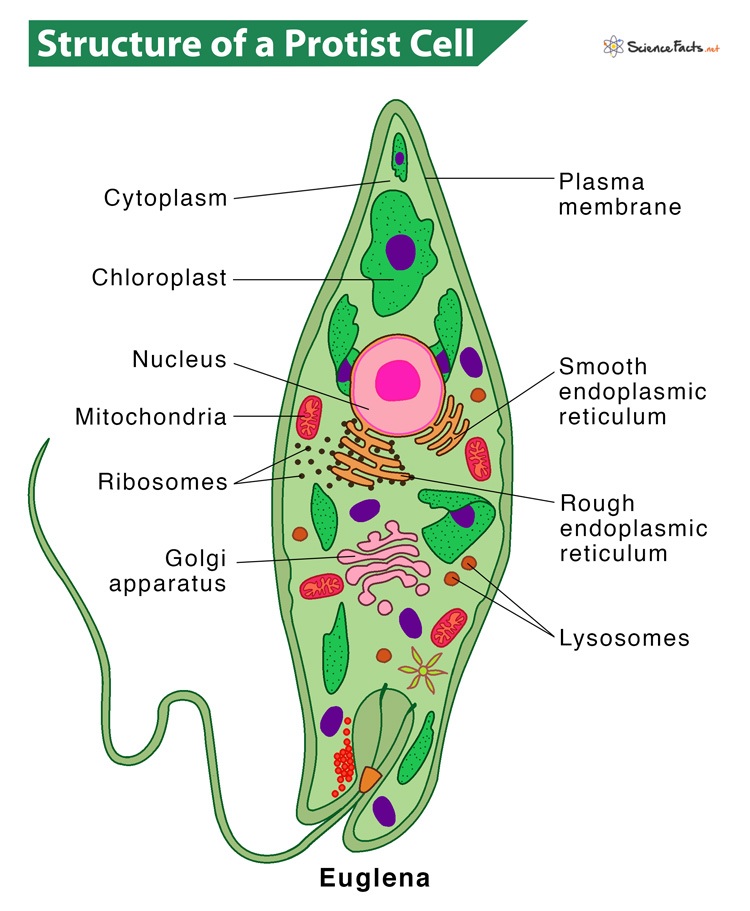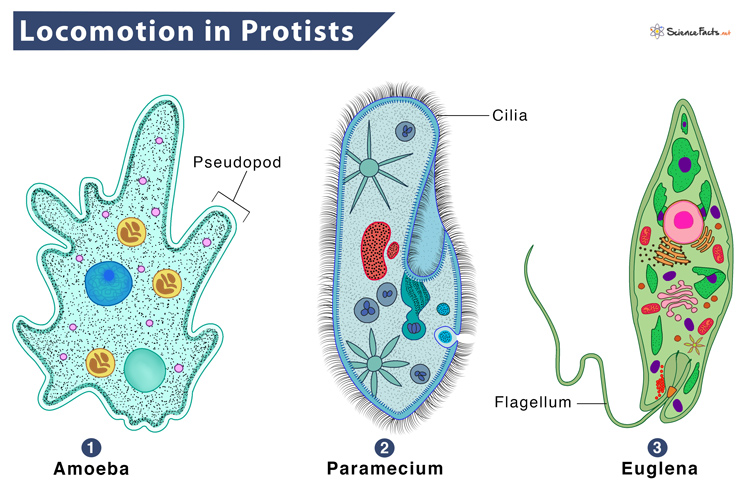In 1866, German scientist Ernst Haeckel introduced the term “Protista,” meaning “primordial” or “first of all.” He suggested placing Protista as a third taxonomic kingdom, with Plantae and Animalia consisting of all “primitive forms” of organisms, including bacteria. However, the emergence of better genetic study has led to a clearer understanding of evolutionary relationships among different groups of protists, thus dismissing this classification system.
Characteristics of Kingdom Protista
Why Are Protists Important
As mentioned, protists are eukaryotes. So, they possess a characteristic central compartment called the nucleus, which encloses their genetic material, DNA. They also have several membrane-bound cellular organelles that execute defined functions within the cell, such as, mitochondria, ribosomes, Golgi apparatus, endoplasmic reticulum, and lysosomes. Some protists contain chloroplasts that serve as the site of photosynthesis. Some protists, such as Trichomonas vaginalis living in anoxic conditions, use an extensively modified version of mitochondria, called hydrogenosome, for some of their energy production. Some protists even have an eyespot, an organelle that helps them to detect light, so they can move toward or away from light as desired. All of their cellular components remain enveloped within a cell membrane or cell wall. In other protists, glassy silica-based shells or pellicles of interlocking protein strips also encase them. The pellicle acts as a flexible coat of armor, preventing the protist from external damage without compromising its range of motion. The figure below shows the cell structure of Euglena, a protist.
Habitat
Most protists exist in various aquatic environments, including freshwater, marine environments, damp soil, and even snow. Some get attached to rocks and reside on the bottom. In contrast, others float on the water’s surface, taking advantage of photosynthesis. In addition to aquatic protists, several protist species reside in host cells within plants and animals as parasites, thus infecting them. Other protists live on dead organisms or their wastes and contribute to their decay.
Metabolism: How Do They Obtain Energy
Protists gain nutrition in different ways. They can be of two major types: photosynthetic or heterotrophs. The protists belonging to a group of photoautotrophs obtain energy by photosynthesis as they have chloroplasts. Other protists, called heterotrophs, consume organic materials to obtain nutrition. These heterotrophs further fall into two groups: phagotrophs and osmotrophs. Phagotrophs surround and swallow food using their cell body, while osmotrophs absorb nutrients from the surrounding environment. Though most protists predominately acquire nutrition by absorbing nutrients from their environment, some may exhibit photosynthetic and heterotrophic nutrient acquisition forms.
Locomotion
The majority of protists are motile, but their modes of movement differ from each other. For instance,
Types: How Are They Classified
Protists are a diverse kingdom. The organisms in this group vary significantly in size, shape, mode of nutrition, and reproduction. They can be unicellular, multicellular, or colonial. All these are reasons why protists are difficult to classify. For ease of study, the kingdom Protista is divided into three sub-categories according to similar behaviors: animal-like, plant-like, and slime mold. Let us explore these sub-categories below:
Animal-like Protists (Protozoa)
Animal-like protists or protozoa are heterotrophic and can move around in their environments to search for food. Out of them, some are herbivores, grazing on algae, while others are predators, preying upon other unicellular organisms. They can be decomposers and parasitic too, consuming dead organic matter and residing in or on living hosts respectively. Protozoa can be categorized into four groups based on their mode of movement.
Plant-like Protists
Plant-like protists, also known as algae, are usually photosynthetic organisms, as most of them contain chlorophyll. They also have a cell wall made of cellulose, like the cell walls of true plants. However, unlike true plants, algae lack stems, roots, and leaves. They live in aquatic (water) environments, and most species are found in oceans, lakes, and ponds. Depending on the pigments present in them, algae are of the following types:
Fungi-like Protists (Molds)
Fungus-like protists are known as molds. Like true fungi, they are also heterotrophic, i.e., absorb nutrients from decaying organic matter in their environment. They also reproduce using spores. However, unlike true fungi, their cell walls contain cellulose rather than chitin. The two major types of molds are as follows:
Reproduction
Protists can reproduce in two different ways. They are asexual mode and sexual mode.
Asexual Mode
The asexual mode of reproduction involves only one parent and produces genetically identical offspring to that parent. Under favorable conditions, protists undergo asexual reproduction more frequently and produce rapid population growth. In addition to the convenience of self-reproduction, this becomes the primary reproduction method of protists. Asexual reproduction occurs in the following ways:
- Binary Fission: In this process, a single parent protist divides its nucleus and then divides itself into two equal daughter individuals by mitosis. Examples: Euglena, Amoeba, and Paramecium.
- Multiple Fission: Here, the parent organism divides into several daughter individuals, except the nucleus. Later the individual divides into separate organisms for each nucleus that has been created. Examples: Amoeba and Plasmodium
- Plasmotomy: In this case, a multinucleate protist divides into two or more multinucleate offspring by dividing cytoplasm without nuclear division. Example: Opalina
- Spore Formation: Some protists produce spores to withstand unfavorable conditions. Upon germination, each spore gives rise to a new individual. Example: Slime molds
- Budding: In this case, a small outgrowth or bud develops from the parent body, which separates and develops into a new individual. Example: Arcella
Sexual Mode
Unlike asexual reproduction, sexual reproduction requires two parent organisms. Both parents contribute genetic material to the offspring, creating genetic variability. There are two methods of sexual reproduction:
- Syngamy: In this case, two gametes fuse entirely to produce diploid zygotes. Syngamy is of three types:
Isogamy: two similar gametes fuse
Example: Monocystis
Anisogamy: two dissimilar gametes fuse
Example: Ceratium
Oogamy: large non-motile gametes get fertilized by smaller motile gametes
Example: Plasmodium 2) Conjugation: Here, two individuals unite temporarily to exchange their haploid pronuclear to form a zygote nucleus. Each one with a zygote nucleus produces daughter individual by binary fission. Example: Paramecium
Life Cycles
Protist life cycles range from simple to complex. Certain parasitic protists must infect different host species at different developmental stages to complete their life cycle. Some protists are multicellular in the diploid form and unicellular in the haploid form. Also, some of them have multicellular stages in both haploid and diploid forms, a strategy also used by plants, called alternation of generations.
Life Cycle of Slime Molds
Slime molds are categorized into plasmodial or cellular types based on their life cycles. Both of these types end their life cycle in the form of dispersed spores. Their detailed life cycles are discussed below: Plasmodial Slime Molds They are composed of large, multinucleated cells. They move along surfaces like an amorphous blob of slime during their feeding stage. They glide along, catch and engulf food particles, especially bacteria. Upon maturation, the plasmodium develops a net-like appearance and form fruiting bodies, or sporangia, during stress. Haploid spores get formed within these sporangia by meiosis. These spores disseminate through the water or air to potential land in more favorable environments. They germinate to form amoeboid or flagellate haploid cells that can combine, producing a diploid zygotic slime mold and thus completing the life cycle. Physarum is a common plasmodial slime mold. Cellular Slime Molds These molds function as independent amoeboid cells when nutrients are abundant. When food is scarce, cellular slime molds aggregate into a mass of cells, called the slug, that behaves as a single unit. Some of the slug cells contribute to a 2–3-millimeter stalk, which dries up and dies in the process. The top cells of the stalk form an asexual fruiting body, which contains haploid spores. Like plasmodial slime molds, these spores can also germinate upon landing in a moist environment. Dictyostelium is a representative genus of the cellular slime molds, commonly existing in the damp soil of forests.
Food source: Protists act as the foundation of the food chain, thus providing a significant food source for many animals.
They provide food to the plant-feeding aquatic organisms in the form of phytoplankton. Also, various sea creatures, including shrimp and larval crabs, feed on zooplankton. Humans also harvest various protists, such as seaweed, for food. Many also consume Aphanizomenon flos-aquae and spirulina in supplements for omega-3 fatty acids and other nutrients.
Ecological benefit: Blue-green algae provide 80% oxygen to the Earth. Some blue-green algae, such as Aphanizomenon flos-aquae and spirulina, produce oxygen as a by-product of their respiration cycle.
Algae, like seaweed, also serve as a mini-ecosystem for other marine life, providing a hiding space for the juvenile and larval forms.
Economic Benefits: Living algae is 50% oil and can be harvested and processed into usable oil, diesel, and gas fuel. Additionally, the algae rapidly grow, allowing producers to keep up with an ever-increasing demand.
Currently, blue-green and brown algae are being grown for biofuel, eventually replacing traditional fossil fuels.
Symbiotic Relationships: Some protists offer more direct benefits for animals in the form of symbiotic relationships.
Some protists, such as Trichonymphs, live in the digestive tracts of several cellulose-eating organisms, like termites. They help those animals by breaking down the wood cellulose into digestible components. Various protists and bacteria also reside in the digestive tracts of ruminants, such as cows, and help them break down the plant cellulose.

